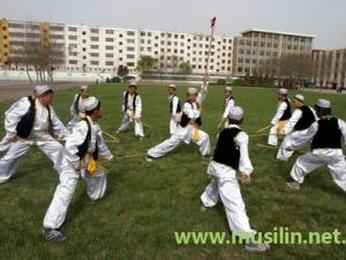Hui Islamic Martial Arts in China
Original Chinese Language Article By: http://islamstory.com
(Translated by Adrian Chan-Wyles PhD) Chinese martial arts has a long history, and is known for its various and distinct martial arts styles and lineages. One such unique fighting-system is known as ‘Yongjian’ (勇健) or ‘Brave Health’ which is associated with the Hui (回) ethnic group in China. The Hui ethnic group follows the Islamic religion in China (and has done so for hundreds of years), and in this time has contributed significantly toward the development of Chinese martial arts from within the practice of Muslim culture.
Tang Ping Seven Step Fist (汤瓶七式拳 – Tang Ping Qi Shi Quan: Hui martial arts are known to have existed as a distinct form at least since the beginning of the Qing Dynasty (and perhaps earlier). Its strength lies in the Hui Islamic culture that is continuous from one generation to the next. Many Hui Mosques (清真寺 – Qing Zhen Si) in China have adjacent a specially consecrated field or training area, where Hui Muslims regularly practice their style of Chinese martial arts for health, self-defence and spiritual reasons. After the early morning call to prayer (昏礼 – Hun Li) or the ‘Maghreb’ (at sunrise) everyone (including men and women) leaves the Mosque and enters the training field and partakes in the solo practice of the fast and snapping punching, blocking and kicking of the unarmed forms associated with the Yongjian martial arts style. The practitioners then transition into the solo performance of weapons forms of the Yongjian style, which quite often includes the use of the ‘spear’ (枪 – Qiang) and ‘stick’ (棒 – Bang). The movements of these martial art forms are perfected to a very high degree. This daily practice also includes the carefully controlled interaction between pairs of performers, who practice fast and sophisticated attacks and defences, which although inherently dangerous, do not cause injury to one another. The Hui people who practice this Yongjian martial art are calm, disciplined and peaceful.
Islamic martial arts are famous throughout China, and are highly respected. Typical Chinese martial styles associated with Hui Muslim culture are ‘Spring Leg’ (弹腿 – Dan Tui), Mind Intention Six Combination Fist’ (心意六合拳 – Xin Yi Liu He Quan), Tang Ping Seven Step Fist (汤瓶七式拳 – Tang Ping Qi Shi Quan), and so on. On the history of Islamic martial arts and the current situation of Islamic peoples in China – please listen to the radio programme on: Reference: http://www.2muslim.com/ ©opyright: Adrian Chan-Wyles (ShiDaDao) 2016. Original Chinese Language Source Text: http://islamstory.com/zh-hans/橄榄灯网络广播电台%20橄榄话语栏目第十期%20《关于回族武术的访谈》 橄榄灯网络广播电台 橄榄话语栏目第十期 《关于回族武术的访谈》 中国武术源远流长,种类繁多,门派纷呈。中国回族历来以勇健尚武著称,有自己独特的武术风格——回族武术。回族穆斯林的武术在中华武林中一直享有盛誉,一些优秀拳种在穆斯林群众中得到了很好的继承和发扬。 自清代至今,回族的尚武传统一直没有断绝,不少清真寺都设有习武场,每日晨礼昏礼之后,大家弹腿打拳,玩枪弄棒,切磋琢磨,互试比赛。 广泛流传于中国穆斯林中的穆斯林武术有查拳、弹腿、心意六合拳、汤瓶七式拳等。关于回族武术的历史与现状,请收听本期节目! 参考:http://www.2muslim.com/ |
